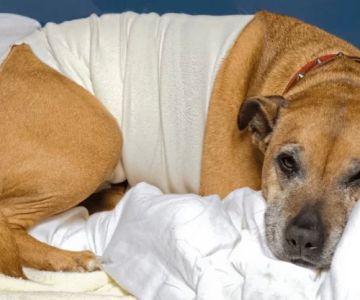Dog Limping After Jumping Off Couch: Causes and Solutions
- Understanding Limping in Dogs
- Why Dogs May Limp After Jumping Off the Couch
- Common Causes of Limping in Dogs
- How to Treat and Care for Your Dog
- When to Visit the Veterinarian
If you’ve noticed your dog limping after jumping off the couch, it can be a concerning sight. Dogs, like people, can suffer from injuries, particularly in their joints and muscles. However, limping after an everyday activity like jumping off the couch might not always be due to a serious injury. Understanding the potential causes of this behavior can help you identify whether it’s something to worry about or just a minor issue that will resolve on its own. In this article, we’ll dive into the common causes of limping in dogs, what to do if you see your dog limping, and when to seek professional help.
1. Understanding Limping in Dogs
Limping is a common symptom in dogs, often indicating discomfort or injury to one or more parts of the body, such as the joints, muscles, or bones. When a dog limps after jumping off the couch, it could be caused by anything from a minor strain to a more serious orthopedic condition. The key to managing this issue is identifying the underlying cause and taking the appropriate steps to help your pet recover.
1.1 Limping: A Symptom, Not a Disease
It’s important to note that limping is a symptom, not a disease itself. Many conditions, such as arthritis, sprains, fractures, or soft tissue injuries, can cause a dog to limp. Identifying the root cause of the limp will allow you to address it effectively, whether through home care or professional veterinary treatment.
1.2 Observing Your Dog’s Behavior
When your dog starts limping, the first thing to do is observe the behavior closely. Notice which leg is affected, whether your dog seems to be in pain, and whether there are any other signs such as swelling, heat, or changes in the dog’s mobility. Additionally, check if the limping only occurs after certain activities, such as jumping off furniture or during exercise.
2. Why Dogs May Limp After Jumping Off the Couch
Jumping off the couch might seem like a simple and natural activity for your dog, but it can put a strain on their joints and muscles. Below are some common reasons why your dog may limp after jumping off the couch:
2.1 Sprains or Strains
When a dog jumps down from a height, especially if they land awkwardly, they can strain or sprain the muscles, ligaments, or tendons in their legs. This can lead to temporary limping. Dogs are more prone to these injuries if they’re older, overweight, or have had previous joint issues.
2.2 Joint Problems (Arthritis)
Arthritis is a common condition in older dogs and can lead to limping, especially after high-impact activities like jumping. If your dog is suffering from arthritis, jumping down from a couch might exacerbate the pain and stiffness in their joints, causing them to limp. This is particularly true for larger breeds or dogs with a history of joint problems.
2.3 Hip Dysplasia
Hip dysplasia is a genetic condition where the hip joint doesn’t develop properly, leading to instability and pain. Jumping or sudden movements can aggravate this condition, causing limping. Hip dysplasia is most common in large dog breeds like German Shepherds and Labradors, but it can occur in any breed.
2.4 Soft Tissue Injuries
Sometimes, soft tissue injuries, such as bruising or tendon damage, can occur when a dog jumps from a height. These injuries might not be immediately obvious but can cause discomfort and limping afterward. Soft tissue injuries may be accompanied by swelling, redness, or heat around the affected area.
2.5 Injuries to the Paw Pads or Nails
If your dog’s paw pads or nails get injured during the jump, it may cause them to limp. Dogs can injure their paw pads if they land on a hard surface or step on something sharp. Check the pads and nails for cuts, tears, or other damage that may be causing discomfort.
3. Common Causes of Limping in Dogs
In addition to the causes listed above, there are several other conditions that may cause limping in dogs. Here are some of the more common conditions:
3.1 Fractures or Broken Bones
A fracture or broken bone can result in immediate and severe limping. If your dog has had a recent fall, accident, or trauma, a broken bone may be the cause. Symptoms to look out for include swelling, bruising, or an inability to put weight on the affected leg.
3.2 Luxating Patella
A luxating patella is a condition where the kneecap slips out of its normal position. It is common in small dog breeds like Chihuahuas and Toy Poodles. When the patella shifts, it can cause sudden limping or lameness. In mild cases, the patella may slip in and out of place, causing intermittent limping.
3.3 Torn Ligaments (Cruciate Ligament Tears)
Torn ligaments, especially the cranial cruciate ligament (CCL), are a common cause of limping in dogs, particularly those who are older or overweight. The CCL connects the femur to the tibia in the knee joint, and when it tears, it causes instability in the knee, leading to limping and pain.
4. How to Treat and Care for Your Dog
If your dog is limping after jumping off the couch, the first step is to keep them calm and limit their physical activity. Here are some general steps you can take to treat and care for your dog:
4.1 Rest and Limit Activity
The most important thing you can do is allow your dog to rest. Limit their movement and avoid any activities that may worsen the injury, such as running, jumping, or climbing stairs. Provide a comfortable and quiet area where they can relax and heal.
4.2 Ice or Heat Therapy
Depending on the nature of the injury, applying an ice pack or heating pad to the affected area can help. Ice helps reduce swelling and inflammation, while heat can relax tight muscles and promote blood flow. Always place a cloth between the ice or heat source and your dog’s skin to avoid burns or frostbite.
4.3 Monitor for Changes
Keep an eye on your dog’s condition. If the limping persists for more than a few days, worsens, or is accompanied by severe pain, swelling, or bleeding, it’s time to visit a veterinarian.
5. When to Visit the Veterinarian
While some minor limping can resolve on its own with rest, there are situations when you should seek veterinary help. If your dog shows any of the following signs, contact a veterinarian:
5.1 Persistent or Worsening Limping
If the limping continues for more than 48 hours or worsens despite rest and care, it’s important to have your dog examined by a professional. Prolonged limping could indicate a more serious injury or condition, such as a torn ligament, fracture, or severe joint issue.
5.2 Swelling or Deformity
Visible swelling or deformities, especially around the joints or bones, should be examined immediately by a vet. These could be signs of fractures, dislocations, or joint damage that require prompt treatment.
5.3 Difficulty Walking or Bearing Weight
If your dog is unable to walk or bear weight on the affected leg, or if they show signs of severe pain, it’s important to seek immediate veterinary care. This could be a sign of a significant injury, like a bone fracture or severe ligament damage.
For expert veterinary care, be sure to visit Hidden Brook Veterinary, where we provide comprehensive services to help diagnose and treat your dog’s limping and other health concerns. We’re here to ensure your pet gets the care they deserve.












